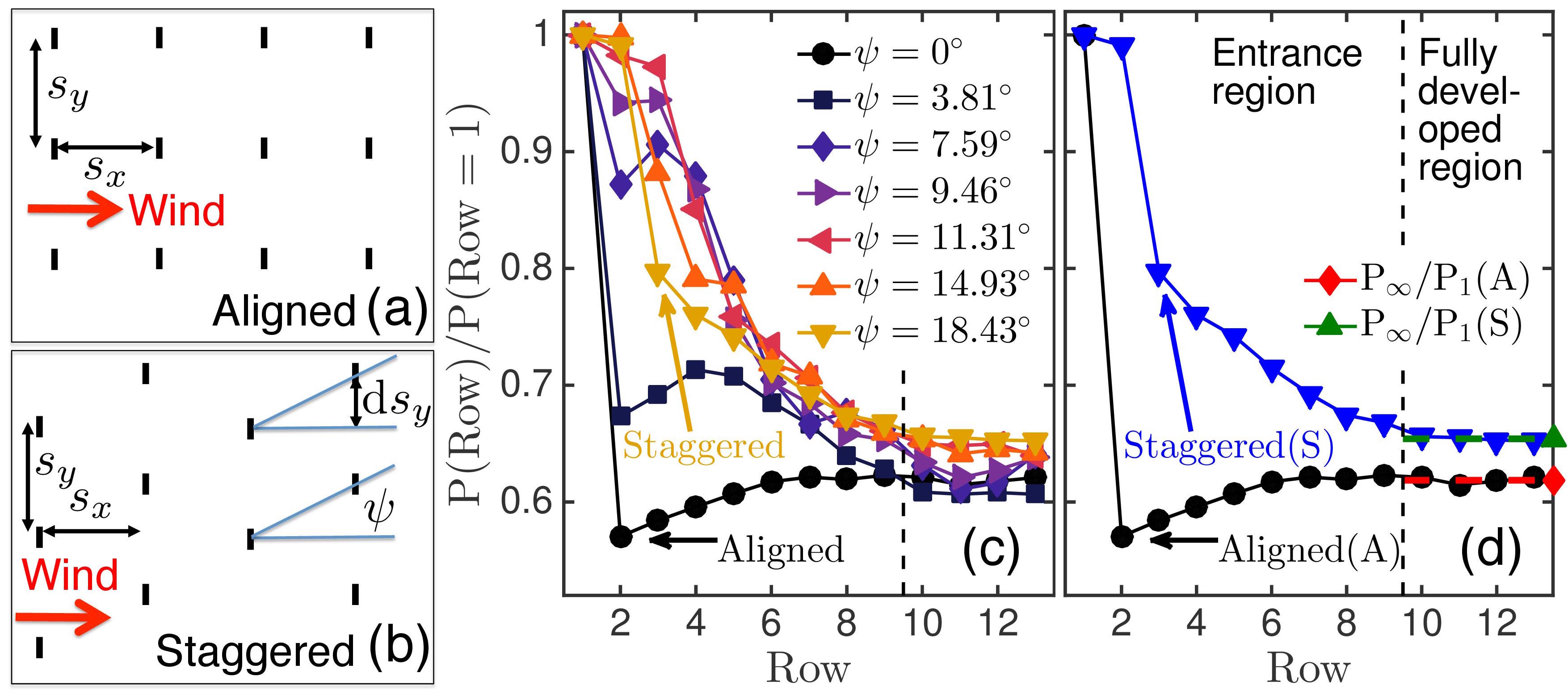Large eddy simulations of wind-farms
Similar to other renewable energy sources, wind energy is characterized by a low power density. Large wind farms (on- and offshore) consisting of arrays of ever larger wind turbines are being envisioned and built in order to make considerable contribution to the world’s overall energy supply. These wind-turbines interact with the environment over a wide range of length scales ranging from millimeters (viscous scales) and meters (wakes and tip vortices) up to ``geophysical scales" of hundreds of meters (inter-turbine spacing) to kilometers (wind-farms). The large scale separation makes analysis and design of wind-farms challenging from both a theoretical and a numerical perspective. However, a detailed understanding of the relevant physics is critical for efficient wind-farm designs that exploit the full potential of this important renewable energy source. High-fidelity simulations allow one to fully specify the conditions under which the wind-farm performance is tested. This makes simulations the ideal tool to obtain insight into the complex interactions that dictate wind-farm performance.
In this project we use large eddy simulations for the development of physics based models that can be used to predict the performance of very large wind-farms, see also modeling of wind-farm performance. Movie 1 shows a 3D perspective visualization of a Large Eddy Simulation (LES) computersimulation capturing the interaction between the atmosphere and a very large aligned wind-farm, see Ref 3 and the corresponding press releases by AIP and FOM. The movie shows that turbulent wakes that are created behind the turbines. In addition, the simulation reveals that the wakes start to interact with each other further downstream. At the entrance of the wind farm white particles are periodically released. These particles spread very quickly and reveal the very turbulent nature of the flow in wind farms. Figure 1 shows the power output as function of the downstream direction for several wind farm configurations and reveals that the power output as a function of the downstream position becomes constant, see figure 1c and d. In this fully developed region the wind-farm dynamics, which are dominated by the interacting wind-turbine wakes, are also influenced by the atmospheric flow above the wind-farm. In recent work we have for example investigated the effect of the wind turbine density on the performance of very large wind farms [7] and the effect of the wind-farm size on the optimal turbine spacing [6].
Movie 1: A three-dimensional visualization of the flow field in a simulated wind-farm. The blue regions indicate low velocity wind-regions. These low velocity wind-regions, which are known as wind-turbine wakes, are found behind the turbines. Visualization made by David Bock (XSEDE (Extreme Science and Engineering Discovery Environment), see also an extended movie on Bock's personal website).

Figure 1: (a,b) Sketches of an aligned and a staggered wind-farm. The sketches show the definition of the streamwise sx and spanwise sy turbine spacing, which are non-dimensionalized with the turbine diameter D. Panel b also defines the alignment angle Ψ=arctan (dsy=sx) with respect to the incoming wind-direction. (c) Power output as a function of the downstream position for sx=7.85 and sy=5.24 and different Ψ. (d) Determination of the power output in the fully developed region (P∞/P1) for the aligned and staggered configuration.
References
-
R.J.A.M. Stevens, C. Meneveau,
Flow Structure and Turbulence in Wind Farms,
Annual Review of Fluid Mechanics, 49, 311-339 (2017).
-
M. Zhang, M.G. Arendshorst, R.J.A.M. Stevens,
Large eddy simulations of the effect of vertical staggering in extended wind farms
Wind Energy (2018) -
L.J. Lukassen, R.J.A.M. Stevens, C. Meneveau, M. Wilczek,
Modeling space-time correlations of velocity fluctuations in wind farms,
Wind Energy 21 (7), 474-487 (2018). -
M. Zhang, R.J.A.M. Stevens,
Exploring a better turbine layout in vertically staggered wind farms,
J. Phys. Conf. Ser. 1037, 072041 (2018) -
M. Zhang, R.J.A.M. Stevens,
Characterizing the coherent structures in large eddy simulations of aligned windfarms,
J. Phys.: Conf. Ser. 854, 012052 (2017). -
R.J.A.M. Stevens, L.A. Martínez Tossas, C. Meneveau,
Comparison of large eddy simulations using actuator disk or actuator line models with wind tunnel experiments,
Renewable Energy, 116 (A), 470-478 (2018). -
R.J.A.M. Stevens, D.F. Gayme, C. Meneveau,
Effects of turbine spacing on the power output of extended wind-farms,
Wind Energy 19 (2), 359-370 (2016). -
R.J.A.M. Stevens,
Dependence of optimal wind-turbine spacing on wind-farm length,
Wind Energy 19 (4), 651-663 (2016). -
L.E.M. Lignarolo, D. Mehta, R.J.A.M. Stevens, A.E. Yilmaz, G. van Kuik, S.J. Andersen, C. Meneveau, C.J. Simão Ferreira, D. Ragni, J. Meyers, G.J.W. van Bussel, J. Holierhoek,
Validation of four LES and a vortex model against stereo-PIV measurements in the near wake of an actuator disc and a wind turbine,
Renewable Energy 94, 510-523 (2016). -
L.A. Martínez Tossas, R.J.A.M. Stevens, C. Meneveau,
Wind Turbine Large-Eddy Simulations on Very Coarse Grid Resolutions using an Actuator Line Model,
34th Wind Energy Symposium, AIAA SciTech, AIAA 2016-1261, 1-7 (2016). -
R.J.A.M. Stevens, D. F. Gayme, C. Meneveau,
Large eddy simulation studies of the effects of alignment and wind farm length,
J. of Renewable and Sustainable Energy 6, 023105 (2014),
Highlighted by AIP News, April 1 2014,
Featured by FOM News, April 3 2014.
Featured by Johns Hopkins Mechanical Engineering news, April 2014,
Most cited J. of Renewable and Sustainable Energy article published since 2014.
-
R.J.A.M. Stevens, C. Meneveau,
Temporal structure of aggregate power fluctuations in large-eddy simulations of extended wind-farms,
J. of Renewable and Sustainable Energy 6, 043102 (2014).
-
R.J.A.M. Stevens, J. Graham, C. Meneveau,
A concurrent precursor inflow method for Large Eddy Simulations and applications to finite length wind farms,
Renewable Energy 68, 46-50 (2014).